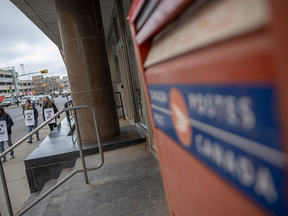Kevin Carmichael: Months ahead will test our bullet-proof banks reputation when debt-service costs rise as five-year mortgages reset
Article content
The head of Canada’s federal banking regulator said a decade of “tightening the screws” has left the financial system ready for the coming shock of higher interest rates.
Advertisement 2
Article content
“I think the system can absorb it,” Peter Routledge, the superintendent of financial institutions, said in an interview.
Assertions of that nature can come back to haunt. Think mission accomplished, budgets balance themselves, or inflation is transitory.
Routledge, a former bank analyst at National Bank Financial, was responding to a question about how inflation and the Bank of Canada’s accelerated march to a more normal interest rate setting looks from the Office of the Superintendent of Financial Institutions (OSFI), which oversees some 350 lenders, trusts, and insurers.
The central bank raised its benchmark interest-rate a half point last month, and governor Tiff Macklem indicated during testimony at the House finance committee on April 25 that he and his deputies probably will execute another half-point increase at their next policy announcement on June 1. That would put the benchmark rate at 1.5 per cent, compared with 0.25 per cent at the start of the year, and Macklem has said on numerous occasions in recent weeks that getting inflation under control could require pushing the rate past three per cent.
Advertisement 3
Article content
“The Canadian economy is in good shape,” Macklem said. “It can handle higher interest rates. It needs higher interest rates.”
The months ahead will test Canada’s reputation for fostering bullet-proof banks. Routledge boasted that no Canadian financial institution failed during (or after) the financial crisis of 2008-09, while nearly 500 American lenders have collapsed over the past 13 years. But Canadian lenders hadn’t spent the years that preceded the Great Recession indulging our lust for real estate to the degree they have over the past decade.
That debt was accumulated during a period of unusually low interest rates; so low, that many first-time borrowers will have no comprehension of the level of debt-service costs that await them when their five-year mortgages reset. Delinquencies could spike, which could trigger a homegrown financial crisis. A less violent threat is domestic consumption slowly shrinks as overstretched households are forced to commit a greater amount of their disposable income to mortgage payments. Both scenarios could cause a recession.
Advertisement 4
Article content

“Consumer spending and some sectors of housing investment will face some important headwinds in the coming years,” Charles St-Arnaud, chief economist at Alberta Central and a former Bank of Canada staffer, said in a report last month. “As a result, there is a risk that growth will be weaker than currently expected. For the overall growth outlook, the question is whether business investment and exports can grow sufficiently to compensate for this weakness.”
Routledge’s confidence that the financial system will remain a firewall against worst-case scenarios shouldn’t be confused with complacency.
He said during the interview that he “kind of” agrees with former Bank of Canada governor Stephen Poloz’s contention that worries over high debt levels are rooted in attitudes that haven’t changed since the Great Depression, and therefore discount the extent to which financial innovation — and more sophisticated approaches to regulation — has made it possible for households to live off credit.
Advertisement 5
Article content
Yet Routledge said he was unwilling to let down his guard on the basis of a theory, no matter how persuasive it might sound. “I kind of agree with Stephen, but I can’t buy into that 100 per cent because my job requires me not to,” he said.
OSFI’s job is maintaining confidence in the financial system by keeping banks and insurers out of trouble. Its clean sheet when it comes to bankruptcies has much to do with the way it approaches regulation. Alan Greenspan, the former chair of the Federal Reserve, the U.S.’s central bank and regulator of the biggest financial institutions, assumed (wrongly) that banks could be trusted to self-regulate. OSFI was never seduced by that philosophy. It issues guidelines that leave it with room to be as prescriptive as necessary. “It’s hard to get a bank licence,” Routledge said. “Part of the reason it’s hard is because we have really high standards.”
Advertisement 6
Article content
That “principles-based” approach to regulation results in iterative rule changes such as the stress test that borrowers must pass before they can get an insured mortgage. You could argue that the stress test should have been applied sooner, as regulation has been a couple of steps behind throughout the era of ultra-low interest rates. But the finance minister — a member of Parliament from the Greater Toronto Area for the duration of Canada’s housing frenzy — would have had to make that call. OSFI is a “micro-prudential” regulator, not a “macro-prudential” one. It issued the stress test when it determined the lenders it oversees were becoming too loose with their definitions of who should qualify for a mortgage.
Advertisement 7
Article content
-

Canada’s economy poised to grow in the first quarter, dodging America’s fate
-

Tiff Macklem acknowledges misjudging inflation, pledges to act ‘forcefully’ to bring it down
-

What rapidly rising inflation tells us about the economy
-

Macklem hints at a second half-point rate hike, while dousing talk he could go bigger
For years, the most fatalistic observers of the Canadian housing scene have been pointing out how Canada’s household debt levels mirror those of the U.S. before that country’s real-estate bust triggered the financial crisis. Routledge said he doesn’t mind such alarmism because it keeps people alert to what could go wrong. But the then-and-now charts that portend disaster in Canada leave little room for nuance. Routledge reckons housing markets will remain buoyant as long as immigration rates exceed the pace at which we’re building new homes. Another important difference is regulation, and specifically the mortgage stress test.
Advertisement 8
Article content
“We’ve constantly been tightening the screws,” Routledge said. “Here’s the difference between 2008 in the United States and 2022 in Canada. Through the boom years, we’re tightening underwriting standards. In the United States, they were loosening them.”
Policymakers and regulators learn from mistakes. The Great Recession taught many lessons, even to those who weren’t directly involved. One of the learnings for Routledge is to stay awake. Among the newer issues on OSFI’s agenda are ensuring banks are ready of cyber attacks and adjusting to ensure increasing competition for financial technology companies occurs in a regulated environment. OSFI is also studying whether the stress test should be expanded beyond mortgages, specifically combined loan products that are based on a borrower’s home loan.
“You never want to say, ‘All clear,’” Routledge said.
• Email: kcarmichael@postmedia.com | Twitter: carmichaelkevin
Advertisement
Canadian financial system can ‘absorb’ shock of higher interest rates
2022-05-02 12:53:59






